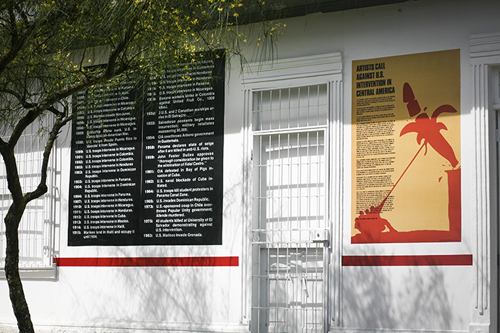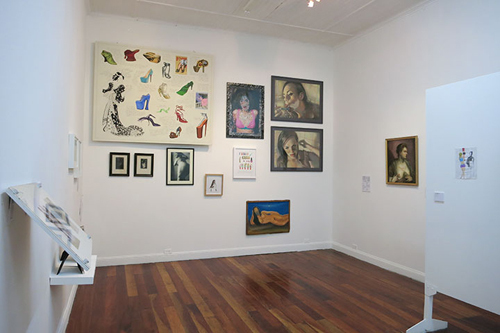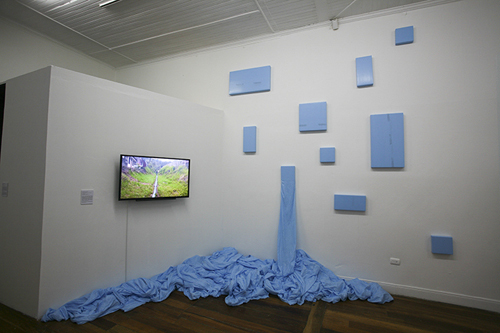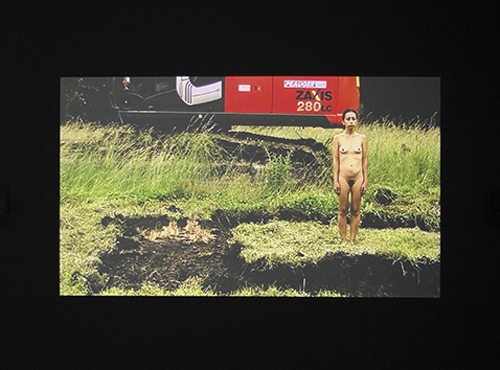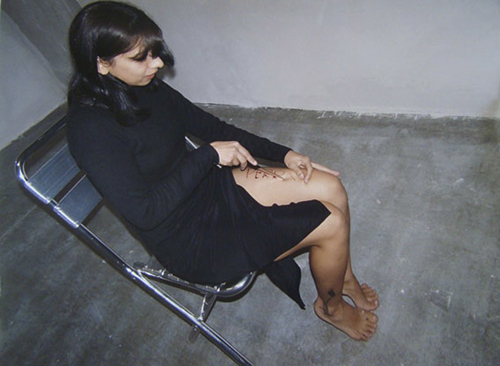It's an unusually cool, blustery day in February in San Jose, Costa Rica and Gabriela Saenz-Shelby, gallery director of TEOR/eTica walks me through their current exhibit, A Chronicle of Interventions, which has just closed in their main exhibition space. Located in the gentrifying Barrio Amon district of the city, where many residences and most stores still have iron bars and gates and barbed wire protecting their property, the 15-year-old independent project and private nonprofit art space was once the family home of the gallery's founder, Virginia Pérez-Ratton, a cultural archivist whose personal collection of over 500 works of contemporary art anchors the space.
The first director of San Jose's Museum of Contemporary Art & Design (MADC), Pérez-Ratton was devoted to the idea of developing support for Central American contemporary art. After all the attention given to the wars and tense political situations of the 1980s, artistic production in the area was largely invisible. She set as her goal to locate what was going on and to create a network, to create a working fiction of Central America as an artistic community. She was invited as a guest curator to the main area of the 49th Venice Biennale, where she showed artists from Central America. One of them, Federico Herrero, was awarded the Plateau of Humankind, a special prize given to a young artist.
For years, Pérez-Ratton successfully sought funding for the region, receiving substantial grants from the Getty Foundation and the Prince Claus Fund in the Netherlands. Then, in 2010, she died of cancer, leaving a trust to continue her work. But there was no one to take over and the gallery closed down for one year, until one of her daughters Dominique decided to reopen the space, hiring Inti Guerrero as curator. Guerrero, who had curated a show with the Tate Modern in 2011, did four shows at TEOR/eTica, including the current exhibition.
Dominique then hired Saenz-Shelby, who joined the staff in 2013. Her first show at the gallery, was the New Fantasy exhibit, an exhibit curated by Guerrero that stirred up considerable media attention. Located just around the corner from a brothel, The New Fantasy, where prostitutes are transgender and transvestites, the show created "a bit of turmoil. We compete with prostitutes and brothels here and people were confused by the show. The purpose of the exhibit was a deep questioning of the establishment, to show that we are socially compromised and to explore issues of gender and minority," Saenz-Shelby said.
A Chronicle of Interventions, curated by Inti Guerrero and Shoair Mavlian, opened in October 2014. Organized in collaboration with the Tate Modern in London, the exhibit presents a powerful artistic response to the history of economic, political, military and foreign interventions in Central America. Referring back to the 1980s, a time of political upheaval, the exhibit draws on photojournalism from the New York based collective Group Material's installation: Timeline: A Chronicle of US Intervention in Central and Latin America 1984 which was shown in the PS1 Contemporary Art Center in Long Island City, NY. That show included more than 50 New York based artists including Leon Golub and Claes Oldenburg.
"We took the archives from the [1984] exhibit and brought them back to the contemporary situation through contemporary artists working with related themes," Saenz-Shelby explained. Included in the current show are seven contemporary artists whose work exemplifies the history and consequences of intervention in Central America. A "mural" to announce the show printed on vinyl and hung on the outside of the building, listed U.S. incursions in Latin America in English--including the Bay of Pigs and the Invasion of Grenada. Several days before the exhibit opened, it was torn down. It has since been replaced and has not been vandalized.
Prominent among the group is Oscar Figueroa, a 28-year-old Costa Rican artist whose video Demeritos (Demerits) from 2013 follows the long river trip from Guatemala to Colombia by laying out a 3,275-meter ribbon of blue plastic. Originally used to prevent banana plants from pests, the plastic boundary was later used by the United Fruit Company, according to the exhibit's catalog: "As a barrier to prevent its workers from traveling beyond a specific territory. The barrier was approved on the pretext of preventing certain diseases from entering the capital city of San Jose but was in fact a blockade to stop the black population of plantation workers from migrating to the capital."
Like Figueroa, Andreas Siekmann, a German artist, takes on the monoculture economy in his 2014 work on vinyl. A researcher and an artist, Siekmann provides global perspectives on the United Fruit Company and its iconic Chiquita, incorporating like signs from Facebook into his work. Also included in the exhibit is a performance video, Tierra (Land) 2013 by Guatemalan artist Regina José Galindo, which shows the artist standing naked in a field. Nearby, a backhoe is digging a mass grave around her. The piece speaks to the massacres and mass interments that occurred during the military regime of José Efraín Ríos Montt (1982-1983). Approximately, 200,000 people died or went missing during the civil war and many were of indigenous descent. At the end of her video, there is a small column left to stand on. The earth is shaking and it is likely that Galindo will fall/disappear.
Galindo is well known for an unsettling earlier performance video (2005) in which she bares her thigh and carves the word Perra (Bitch) into her skin with a knife. Intended to confront and condemn gender violence, the artist struggles with her pain, covers her leg and ultimately walks away. The piece, according to Prof. Kency Cornejo, is a vivid contrast to the women revolutionaries who were depicted in posters, holding a child in one arm and a gun in the other. "It calls attention to bodies of victims who have been found with the reasons for their death carved on them, to lives taken as punishment for sexuality," she said, in recent talk on "Femicide and Feminisms in Central American Art" at the College Art Association (CAA) meetings in New York City.
Retaining the feeling of a private home, TEOR/éTica has devoted a small room to political art. On view in February was Costa Rican artist Marton Robinson's Y Que Fue De Cocori?And What Happened to Cocori? --an exhibit curated by Lina Castañeda Bonilla that questions racism in Costa Rica. "Everyone here knows the story of the little boy who lives in Limon," Saenz-Shelby said referring to the Costa Rican novel Cocori by Joaquin Gutierrez, a children's story about a Caribbean boy named Cocori and a blonde girl on vacation. The book is often perceived as racist and stereotypical, Saenz said, "but what happened to Cocori?" What is the legacy of racism?
Densely packed with historical objects including Negriti-ticos (2014) two mechanical bank heads, Robinson's exhibit includes four identical serigraphs in which he used a mixture of blood and semen as ink. It is a reminder that many whites in society considered the blood of the black race as a threat. Each self-portrait is posed to replicate the image that a slave owner would take of a slave. The title of the series in which Robinson's face becomes successively whiter and more invisible is El blanqueamiento de la sangre (The Whitening of the Blood, 2014). The work was based on the pseudo-scientific belief that the black race could be improved by intermixing it over successive generations with whites. Ironically, since blood and semen are biological materials which attract mold and fungus, Robinson's work has turned darker over time.
A video on one wall shows Joel Campbell, a black Costa Rican soccer player, who participated in the World Cup in Brazil, in sneakers jumping up and down, as if scoring goals in a basketball net. Campbell places the letters spelling out Costa Rica above the basket as he jumps, while Robinson adds in background audio where racist epithets are hurled against black players.
Across the street in a second building owned by TEOR/éTica, is a space devoted to showing works from Pérez-Ratton's permanent collection of Costa Rican art, and exhibits from artists throughout Central America. Two staff members are currently traveling looking for artists to be shown in this space. On view in February was EMERGENCIA, with 20 artists drawn from the Pérez-Ratton collection as well as three invited artists: Diana Barquero, Guillermo Vargas Habacuc, and Stephanie Williams. The building also houses a library. TEOR/éTica is currently working with art students from UCLA and the gallery hopes to start a digitalization project in the future.
Maria P. Malavasi, Archivist Manager and research coordinator spoke about TEOR/éTica's past, present and future challenges at the CAA panel on Central American Art. In her remarks, "Operative Fictions: Rethinking Art Practices in Central America," Malavasi argued for dispensing with territorial limits and thinking in terms of an expanded Central America. "Territory is becoming increasingly irrelevant," she said. "New models for art in Central America are evolving, born of images of violence. For many contemporary Central American artists, there is a restaging of historical violence in their work as artists and writers create their own narratives."
With Central Americans now the third largest Latino group in the United States, there is an expanded sense of Central American art. Malavasi screened images from Yoshua Okón's video Octopus, a colloquial name for Chiquita. The video, which was presented at the Hammer Museum in Los Angeles in 2011, involved a restaging of violence in a suburban parking lot. She also showed photographer Alma Leivas's Celda #6 (from her Prison Cells series) from 2010, a digital print of a staged living room. There is confetti, candy, and a piñata on the floor. Lurking on the left side of the print is an ominous ghost of a figure. On the wall, there is a calendar. Often taking months to restage a room, Leivas's goal is to show narco-terrorism and the lives of people who have become prisoners in their own homes.
"The idea of a Central American Diaspora is not discussed much in Costa Rica," Malavasi said. "Art here is moving towards more personal topics: the city, on being poor and urban, on being free of violence, on sexuality and on relations with the family." Pausing a bit to reflect, Malavasi added a little confession: "We hide our social conflicts and race conflicts. The art scene in Costa Rica was developed by the elite, by those who studied at private high schools. We haven't opened up space to others. As a culture, we are used to sweeping things under the rug and being the happiest country in the world."
Strong words from a young woman who will be curating the next TEOR/éTica exhibit, Teramorfosis (Teramorphosis) which will be opening on March 11th and running till the end of May. Since Inti Guerrero left in November, TEOR/eTica has been looking for a new curator and there are now several experienced candidates currently being considered. With minimal support from the state, Saenz-Shelby has worked hard to restructure the gallery by rethinking plans for funding and a support mechanism, and by instituting open calls. Her goal is to put on three shows a year in the main gallery, with an additional three in the small room, and another two across the street.
Malavasi's upcoming exhibit reflects research that she has conducted in Costa Rica about how artists of her generation (25-35 years) are exploring "certain monstrous, sinister or deformed aspects of San Jose and different social structures within this city." The show includes art by 12 young Costa Rican creators who work in different areas, ranging from architecture, sound art, and visual arts to graphic design, urban interventions and performance.
One thing is certain, given TEOR/éTica's history, the exhibit will not be timid. Stay tuned!
TEOR/eTica Facade
Andreas Siekmann Chronicle of the United Fruit Company Chiquita Brands, 2014
New Fantasies Installation, TEOR/eTica
Oscar Figueroa, Demritos, 2014
Regina Galindo Tierra, 2013
Regina Galindo Perra, 2005
All Images Courtesy of TEOR/eTica
